Nature Trail Tour
The self-guided nature trail starts in the parking lot at the west side of the museum. It is an easy one-half mile walk which takes about 30 minutes to complete. The information below will introduce you to American Indian people of the area, and some of the animals, plants, and natural features that were important to them.
The desert is a fragile place. A delicate balance must be preserved among its natural elements for the survival of all. Accordingly, please observe the following rules:
- All animals, plants, and rocks within the State Park boundaries are protected by law and are not to be removed or disturbed.
- Dogs are not permitted on the trail.
- Please stay on the trail at all times. Certain resident species of snakes are venomous. In the unlikely event that you encounter a snake on your walk, simply stop and let it go its own way.
There are a total of 14 posts along the trail. The numbers below correspond with the numbers on each post.
.jpg) |
| Map depicting Nature Trail route |
1. People of the Antelope Valley
The Antelope Valley comprises the southwest corner of the Mojave Desert, and is about 75 miles long. During the past 1,000 years or more, the Antelope Valley was inhabited or frequented by several American Indian groups including the Serrano, Kitanemuk, Tataviam, and Kawaiisu.
They had a unique relationship with their environment. In addition to the wide variety of plant and animal resources available in the Antelope Valley, easy access from all directions and numerous flowing springs made the valley an ideal corridor for trade among many different groups of American Indians. The people of the Antelope Valley traded resources from the far reaches of the Mojave Desert to the east, the Owens Valley to the north, and the Los Angeles and Santa Clarita Valley areas to the south. Goods from throughout the American Southwest and California found their way here.
2. San Gabriel Mountains
The high peaks that you see on the southern horizon are the San Gabriel Mountains. Both the foothills and the higher slopes of this range provided a varied food resource base for the native inhabitants of the Antelope Valley. For example, oak trees and pinyon pine trees, producers of two aboriginal food staples —the acorn and pinyon pine nut, respectively— grow in close proximity to each other.
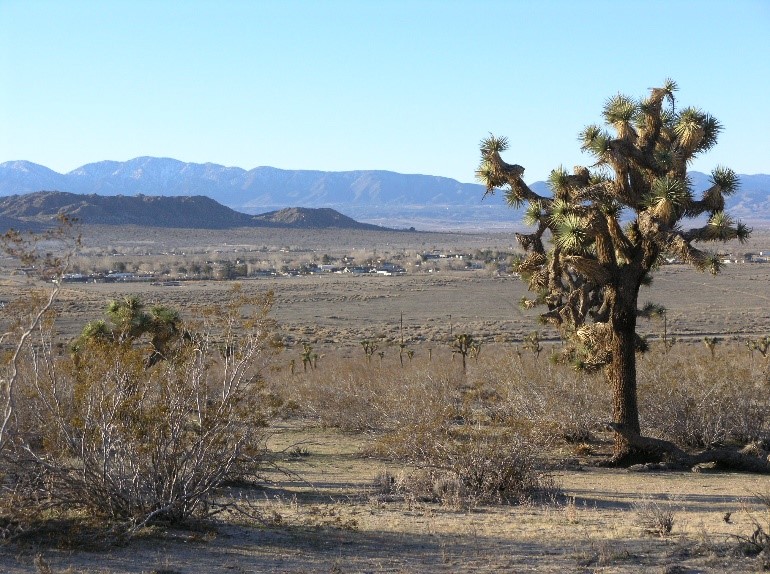 |
|
View to the south. The brown hill in the middle distance is Lovejoy Butte. The San Gabriel Mountains are the range behind Lovejoy. |
3. Ground Squirrels
While the American Indians of the Antelope Valley hunted and trapped certain animals, meat did not comprise a very large part of their diet. They made every effort to use the entire animal and tried to waste nothing. The pelts were fashioned into clothing while the bones were made into tools and implements.
As you look around this area, you may spot an antelope ground squirrel as it scurries about searching for seeds. This small creature (which resembles a chipmunk) is one of the few desert mammals active during the daytime, although it may retreat into its burrow during the hottest part of the day. Although small, the native people of the Antelope Valley made use of rodents such as the antelope ground squirrel for food.
Even if you don’t see any animals, you may notice openings to underground burrows located near the bases of plants. If you should see a distinct crescent or half-moon shaped opening, it is most likely the burrow of a desert tortoise. These slow-moving reptiles are herbivores (plant eaters) and have the ability to store water in their bodies. Although the native people the Antelope Valley sometimes ate desert tortoises, if you have the good fortune to spot one of these gentle and sensitive creatures, please do not disturb it because it may lose its water reserve and perish.
.jpg) |
|
California Ground Squirrel |
4. Barn
At this point as you look toward the north you will see an old barn and corral which were built by Howard Arden Edwards, the founder of the museum, in 1932. Originally they were located east of the museum, but the museum’s second owner, Grace Oliver, moved them here before she constructed the cottages in the 1940s. The barn and corral are considered to be historic structures, so we ask our visitors to help us in our preservation efforts by avoiding them.
.jpg) |
| Barn built by H. A. Edwards |
5. Rabbits
As you walk along the trail, you may be startled by a jackrabbit or cottontail as it darts rapidly from beneath a bush. Although these two creatures have certain similarities, they are actually separate species. The jackrabbit is a hare while the cottontail is a true rabbit. Hares build their nests above ground and their young are born fully furred with their eyes open. Rabbits build their nests in burrows and their young are born hairless with their eyes closed. Rabbits were the most common animals the American Indians hunted for food in the Antelope Valley. People used the skins to make rabbit skin blankets that they wore in cold weather and at night. Each blanket required 100 rabbit skins.
If you listen you might hear coyotes yelping from up on the butte. Coyotes often frequent the area around the museum, but they are shy and stay up in the rocks if there are people around. Coyote plays a role in many of the stories the native people of the Antelope Valley tell about early times, when animals were like people.
.jpg) |
|
| Cottontail Rabbit |
.jpg) |
| Rabbit skin blanket |
6. Grinding Rocks
Flat rock outcroppings (called “bedrock”) were often used by the native people of the Antelope Valley as grinding surfaces for crushing and pulverizing seeds and nuts into flour. Over long periods of time, the pounding and grinding action leaves polished areas on the surface, called grinding slicks, or deeper depressions, which are known as bedrock mortars. A handstone (or “mano”) used for grinding was found near this very boulder.
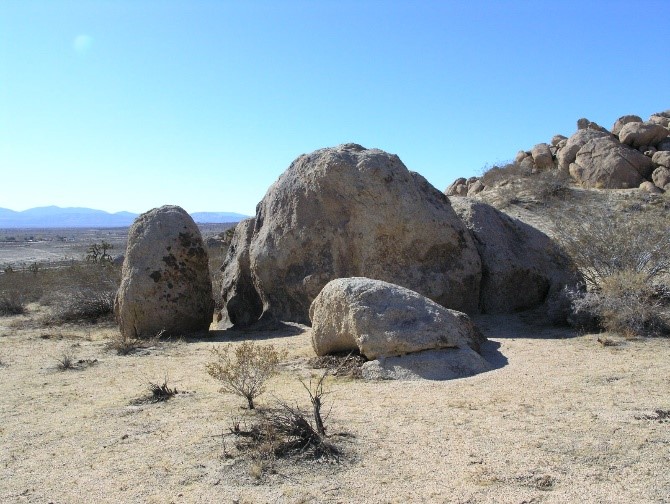 |
.jpg) |
| Rock Outcrop | Mano |
7. Joshua Tree
As you view the landscape in this area, you may find it interesting to note that many of the plants you see around you were once used by American Indians for food, medicine, shelter or fiber.
If there is one single feature which best symbolizes the Mojave Desert, it is the Joshua tree. This unique plant does not grow in any other desert. Like most desert plants, the Joshua tree is known as a “xerophyte” because it uses very little water. As a result it cannot grow very fast —the annual growth rate of these trees is measured in inches. However, they still grow to an average height of 10 to 30 feet, and a few grow even taller. There is no method known to determine the true age of a Joshua tree because it does not produce growth rings.
The Kawaiisu harvested bark from the roots of the Joshua tree to create the dark brown designs on their baskets. Many native people of the Mojave Desert ate the immature Joshua tree seed pods.
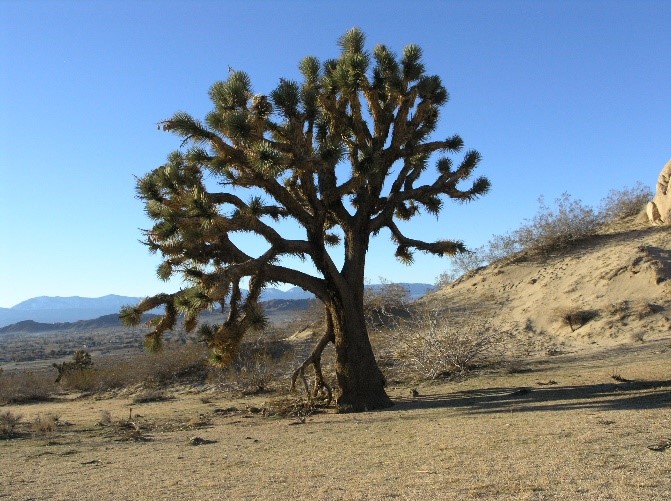 |
| Joshua Tree |
.jpg) |
| Kawaiisu Basket |
The creosote bush is the most conspicuous and widespread shrub in the Antelope Valley. It grows to an average height of 4 to 6 feet, and competition for water keeps the bushes spaced well apart. The many branches and twigs bear small evergreen leaves; the resin which coats the leaves emits a distinctive aroma which has given the plant its unusual name. In the spring, the creosote blossoms with many beautiful yellow flowers which gradually turn into furry white “seed balls” as spring gives way to the heat of summer. The Kawaiisu boiled creosote leaves to make a wash to ease soreness.
8. Rice Grass
As you look toward the sand hills, you may notice a tawny-colored grass which grows in clusters. This is known as rice grass, an important food source for native groups which inhabited the valley. Rice grass was gathered in small bunches, and the stems were set on fire. After the “chaff” burned away, the seeds were left exposed for picking. The seeds were ground into flour, which was then made into mush or cakes.
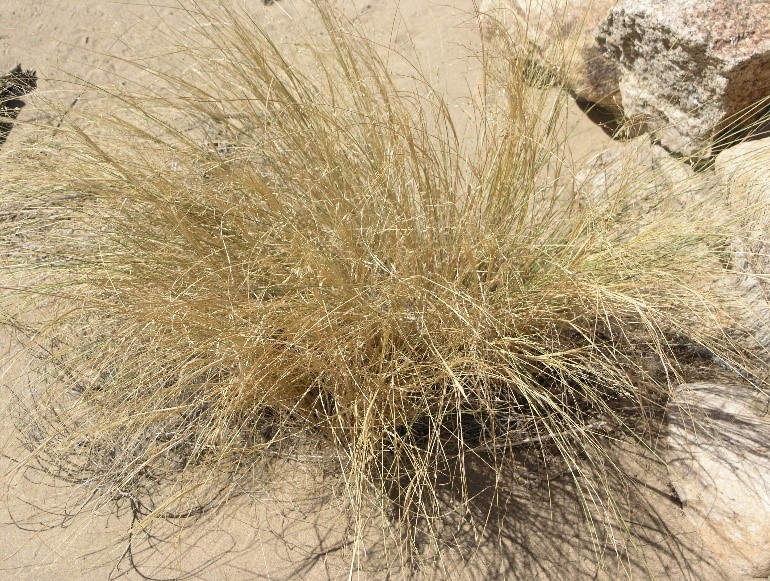 |
| Rice Grass |
9. Fiddleneck
In the spring, you may see green stalks that curl at the top and have yellow flowers. This is fiddleneck, and it was an important fresh green for American Indians of the Antelope Valley after a winter of living on dried nuts and seeds. The Kawaiisu ate the fresh leaves with salt. However, this plant is known to be toxic to animals.
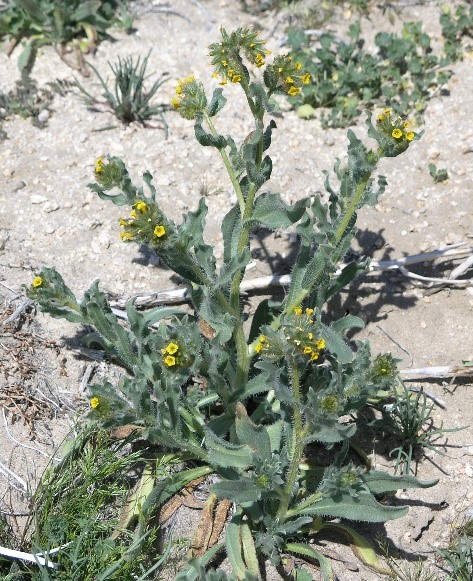 |
| Fiddleneck |
Wild rhubarb is another spring green. You may see some of these plants growing in the sand dune near the rocks. Wild rhubarb has large cabbage-like leaves and a central stalk with reddish flowers. The native people of the Antelope Valley ate both the stems and seeds. The leaves, however, are poisonous.
10. Rock Formations
The butte on which the museum is located is known as Piute Butte. The granite rock formations of Piute Butte are easily the most striking feature of the desert landscape along this portion of the trail. These formations are constantly being eroded into many fascinating shapes and forms. The American Indians modified and enhanced some of these rock formations for spiritual purposes. A concentration of modified rocks is located in the canyon, the mouth of which you can see from here.
As you study the cliffs, you will probably see some of the birds that roost or nest there. Many different species can be observed because most desert birds tend to be active during the daytime. One reason for this is that birds can tolerate higher temperatures than most desert creatures.
The most common birds at Piute Butte are ravens. These large black birds can often be seen engaging in aerobatic displays. When they fly overhead, their wings make a whooshing sound.
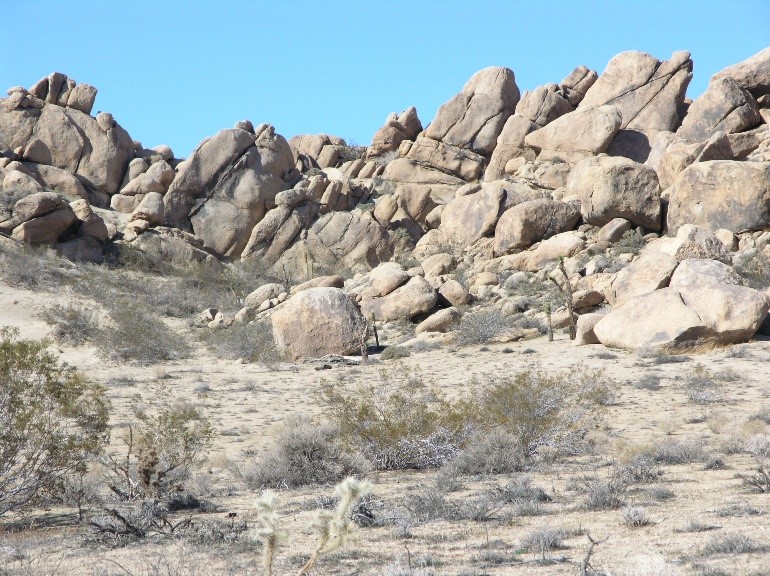 |
| Entrance to hidden canyon |
You may spot a red-tailed hawk soaring high above the cliffs. It is the most frequently seen hawk in the Antelope Valley and can be recognized by its distinctive reddish tail feathers. Like all raptors or birds of prey, it has very keen eyesight and can detect the slightest movement on the desert floor as it searches for food.
11. Lovejoy Springs
The eastern part of the Antelope Valley is distinguished by a number of rocky promontories known as buttes. The one directly to the south is Lovejoy Butte. There once was a natural spring near its eastern edge which contributed to the support of one of the largest American Indian settlements yet discovered in the Antelope Valley. Piute Butte has also yielded evidence of native occupation.
.jpg) |
|
Mortar bowl from American Indian village at Lovejoy Springs. Note the unusual oval carving on the side. |
12. Pictographs
In addition to enhancing natural rock formations, the American Indians also painted pictographs on Piute Butte. A small pictograph panel is located on the large rock face to your north. Because the native people have not had an opportunity to maintain this pictograph panel for over 100 years, it has faded and eroded. Today it is difficult to see without photographic enhancement.
13. Theater of the Standing Rocks
Museum founder Howard Arden Edwards used the natural amphitheater to your north as the setting for the annual outdoor pageant he staged from 1932 to 1935. He called it the Theater of the Standing Rocks. People drove here on dirt roads from as far away as Los Angeles and camped on the sand under the Joshua trees and the stars after watching the play.
.jpg) |
|
The pageant set at the Theatre of the Standing Rocks in the 1930s |
14. Recent Development
The settlement of the Antelope Valley over the past century or so has resulted in many profound changes. As you walk back toward the museum, you may notice the roads and trees of the housing developments on the valley floor to the south. When the museum was built, this area contained only a few farms and dirt roads.
As you look once again toward Lovejoy Butte, you may reflect that the spring which once flowed there is now dry – largely because of development which has taken place in the area.
Where are the bands of pronghorn antelope which once roamed the valley? The future of the desert depends upon all of us – how we choose to use it (or abuse it). Near the front entrance to the museum, an inscription appears on the wall carrying an appropriate message:
We place our treasures in your care, feeling sure that you will not abuse our confidence — for as the Navajo say — “He who creates beauty never tires, but he who destroys beauty is already dead.”
.jpg) |
|
The view of the museum from the top of Piute Butte, ca. 1939 |
